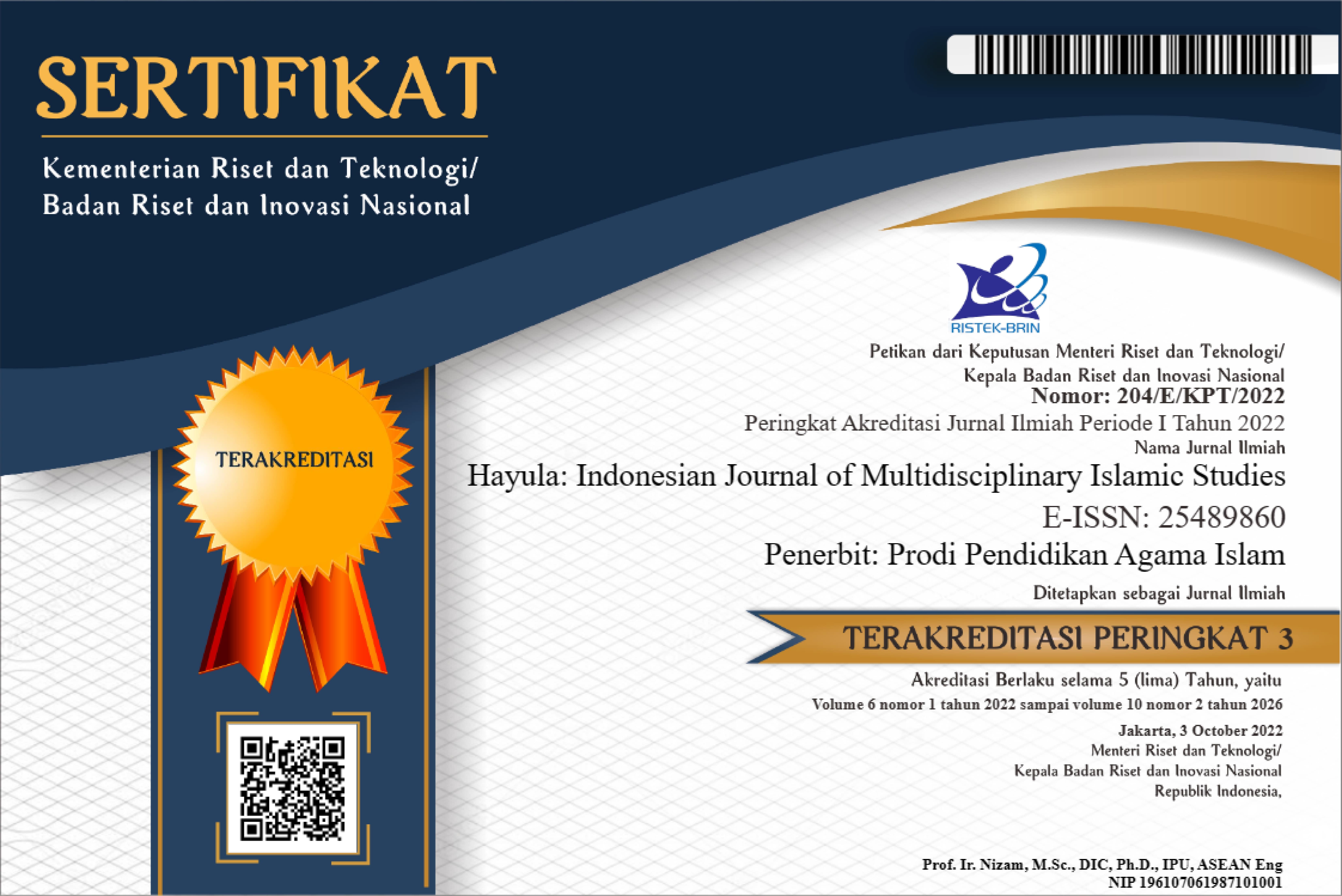Mengenal Sepintas Islam Nusantara
DOI:
https://doi.org/10.21009/hayula.001.1.01Keywords:
Islam Nusantara, Indonesian Muslim, usul, furu’Abstract
The present research explains the basic concept of Islam Nusantara (IN) and its related concepts. IN is a concept that explains the patterns of thought and behavior of Indonesian moslims as reflections of the way they comprehend, teach and implement the Islamic teaching which have a typical of Nusantara. IN is not a new school in the history of Islam. It is about methods (manhaj) and manners (kayfiyah) used by Muslim scholars in Nusantara to spread the Islamic teachings, which can be easly understood and implemented by the people of Nusantara. In addition it also a means of preserving authenticity and validity of Islamic teaching by protecting the fundamental tanets of Islam (usul) and at the same time opening the opportunity for creativity to the non fundamental tanets of Islam (furu‘). By doing so, it will create a pattern of thought, tradition, culture and character if Islam, which are tipical of Nusantara.
References
al-Kubi, S. b. (1432H). Hashiyah ‘ala al-Qaul al-Mukhtar fi> Sharh Gha>yah Al-Ikhtishar(Muhammad bin Qasim al-Ghazzi) (1 ed.). Maktabah Al-Ma’arif.
Baso, A. (2014). Islam Nusanatara: Ijtihad Jenius dan Ijma’ Ulama Nusantara. Tangerang Selatan: Pustaka Afid.
Beras, P. T. (2015). Pokok-Pokok Pikiran Seminar Islam Nusantara. Jombang.
Bizawie, Z. M. (2016). Masterpiece Islam Nusantara: Sanad dan Jejaring Ulama-Santri (1830-1945). Jakarta: Pustaka Compass.
Dahlan, A. (2014). Sejarah Melayu. Jakarta: Kepustakaan Populer Granmedia.
Dahlan, A., & Baso, A. (2014; 2015). Sejarah Melayu. Jakarta: Kepustakaan Populer Granmedia.
Drewes, G. (1969). The Admonitions of Syech Bari (A 16th Century Javanese Muslim Text Attrebute to the Saint of Bonang, Re-edited and Transtated With an Introduction). The Hague: Martinus Nijhoff.
Hasyim, W. (2011). Mengapa Saya Memilih NU. Bandung: Mizan.
Kartodirdjo, S. (1979). Metode-Metode Penelitian. In M. P. Dokumen, & Koentjaraningrat (Ed.).
Mulyono, S. (1975). Wayang: Asal-usul, Filsafat dan Masa Depannya. Jakarta: BP. ALDA.
Muslimdaily.net. (n.d.). Retrieved from http://www.muslimdaily.co/artikel/studiislam/wejangan-agama-dari-era-sekitar-wali-jawa.html
Nasuhi, H. ( 2009). Serat Dewa Ruci; Tasawwuf Jawa Yosodipuro I. Jakarta: Ushul Press dan UIN Jakarta Press.
Nasuhi, H., & Ruci, S. D. (2009). Tasawwuf Jawa Yosodipuro I. Jakarta: Ushul Press dan UIN Jakarta Press.
Nijhoff, T. H. (1969).
Sunyoto, A. (2011). Atlas Wali Songo. Jakarta: Transpustaka.
Syihab, M. A., & Asy’ari, H. S. (1994). Perintis Kemerdekaan ‎Indonesia. Yogyakarta: Kurnia Kalam Semesta dan TIP.
Ulum, A. (2011). Ulama-ulama Aswaja Musantara yang Berpengaruh di Negeri Hijaz. Yogyakarta: Pustaka Ulama.
Umam, S. (2005). Pustaka Tokoh Bangsa. Yogyakarta: LKiS.
Wiwoho. (n.d.). Tembang Dakwah Walisongo . Retrieved from http://bwiwoho.blogspot.co.id/2013/04/suluk-tembang-dakwah-walisongo-5-ilir.html.
Zuhri, S. (‎1983). KH. Wahab Chasbullah Bapak Pendiri NU. Yogyakarta: Pustaka Fatahiyah.
Downloads
Published
How to Cite
Issue
Section
License
Authors who publish with this Journal agree to the following terms:
- Author retain copyright and grant the journal right of first publication with the work simultaneously licensed under a creative commons attribution licensethat allow others to share the work within an acknowledgement of the work’s authorship and initial publication of this journal.
- Authors are able to enter into separate, additional contractual arrangementfor the non-exclusive distribution of the journal’s published version of the work (e.g. acknowledgement of its initial publication in this journal).
- Authors are permitted and encouraged to post their work online(e.g. in institutional repositories or on their websites) prior to and during the submission process, as it can lead to productive exchanges, as well as earlier and greater citation of published works.
Users/public use of this website will be licensed to CC BY







